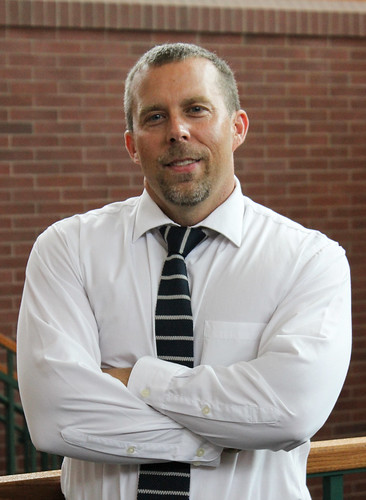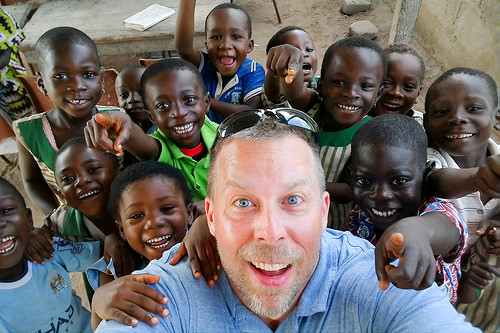Don Wettrick An Innovative Teacher
Writer / Frieda Dowler
Photographer / Jim Eichelman; Provided
 What would better prepare high school students for the future? Don Wettrick believes it’s Innovation Thinking. Others agree with him.
What would better prepare high school students for the future? Don Wettrick believes it’s Innovation Thinking. Others agree with him.
Wettrick, a Greenwood resident, was the recipient of the prestigious Indiana Innovation Award given by Centric October 15 at Clowes Hall, Butler University. Centric is a central Indiana organization that connects, supports and celebrates innovation in business.
Wettrick has introduced Innovation Thinking in a pilot course at Noblesville High School, authored a book on the subject, blogs about it and speaks internationally on the importance of exposing high school students to Innovation Thinking.
Innovation Thinking – The Future
Innovation Thinking identifies opportunities, then allows for creative thinking, problem-solving and risk taking whether in business environments, nonprofits or academia. It is not problem-focused thinking, but it is solution-focused and action-oriented.
Innovation Thinking draws upon logic, imagination, intuition and systemic reasoning to explore possibilities of what could be and to create desired outcomes that benefit the end user (the customer). It involves both analysis and imagination. It’s the method used by companies like Google and Microsoft who have come up with new solutions for problems that arise in a changing world.
When companies such as these look for employees, they seek individuals who can work in an environment of creativity and innovation. Wettrick knows this, and that’s why he wants to include Innovation Thinking as a part of high school curriculum. He wants to make education exciting and beneficial for students.
Daniel H. Pink, a former White House speechwriter and pioneer in Innovation Thinking, claims that a shift in our workforce needs is well underway. In his 2006 book, “A Whole New Mind: Why Right Brainers Will Rule the Future,” he says, “We are moving from an economy and society built on the logical, linear, computer-like capabilities of the Information Age to an economy and society built on the inventive, empathetic, big-picture capabilities of what’s rising in its place, the Conceptual Age.”
Education Prepares for the Future
Wettrick believes American education isn’t adequately preparing students for the type of work environment that has emerged. Academia currently trains students to work toward a predetermined end result.
With the use of technology, the ability to collect information, collaborate with others globally and create solutions is endless. Even though technology is used in the classroom, the time to process the information and form new solutions in a changing world is being left out.
Wettrick’s book, “Pure Genius: Building a Culture of Innovation and Taking 20 Percent Time to the Next Level,” explores what Innovation Thinking looks like in the classroom. His class at Noblesville High School, Innovation and Open Source Learning, includes 20 percent time, a practice of spending 1/5 of the allotted time processing information in order to come up with solutions.
A New Approach
In his classroom, Wettrick challenges students to question everything. He says, “To know or to want to know is to achieve,” and he encourages them to research, interview and be aware of things that need to be improved. He is teaching them to think, process and create solutions, not simply to memorize information that will be required on the next multiple-choice test.
Rather than passively listening to a set of directions for a predetermined outcome, students in Wettrick’s classroom are given time and space to create their own learning experience.
During the first six weeks of class, students choose a project and find an outside mentor for the yearlong course. They also set up a blog, a YouTube channel (youtube.com/user/dwettrick), and Twitter (@DonWettrick) presence where they share their discoveries.
During the class period, they research, interview and develop prototypes. Friday is reflection day when they blog. This year’s projects range from writing apps to developing a light pollution ordinance for the city of Noblesville.
Since cutting edge businesses are operating like this now, Wettrick believes high schools should create the right environment and facilitate Innovation Thinking, so they are prepared for the future workforce.

Learning to be a Thinker
Students learn the 3 C’s of Innovation Thinking, the components of problem-solving:
1. Collect
2. Compute
3. Communicate
Five skills of learning to be an Innovation Thinker are:
1. Cognitive skill of associating
2. Behavior skill of questioning
3. Observing
4. Networking
5. Experimenting
Wettrick’s classroom celebrates failure as well as success but refers to it as “numerous prototypes.” By giving students permission to fail, he eliminates having the goal of success rather than having the goal of learning.
He tells them to think like an entrepreneur now because they are in a classroom lab where they have no startup cost and don’t need to make a living since they still live at home. His goal is for them not only to be employable but to be able to employ others, and he wants them to start thinking that way now.
Wettrick’s classroom incorporates all the basics of education but allows time for students to think deeply about problem-solving. Their success from his motivation is why he gets excited. He says showcasing the students’ work is what won him the Indiana Innovation Award from Centric.
 The Inspiration
The Inspiration
Wettrick was a middle school teacher at Greenwood for 10 years. Then doors opened for him at Franklin High School teaching broadcasting for five years. That exposed him to many opportunities, and he received numerous awards in that field before taking the position at Noblesville High School two years ago. When the Franklin principal moved to Noblesville High School, he made plans for Wettrick to join him and set up the pilot course.
Pink’s Ted Talks on YouTube (v) about Innovation Thinking inspired Wettrick. He began his blog on the subject three years ago and wrote his book in 2013 after traveling Europe. His teaching schedule at Noblesville High School permits him to travel globally since he is also a sought-after speaker on the topic. When Wettrick’s father learned of his decision to become a teacher, he said, “I don’t mind if you teach for the next 20 years. Just don’t teach one year 20 times.” He took his dad’s admonition seriously and says now, “I feel so alive because we’re learning new things.”
The Future
When they said computers would take over American jobs, they were right. In order to stay a step ahead, people like Wettrick will develop in humans what machines can’t do – that is to think or solve complex problems that don’t have a routine solution or to communicate, which is to persuade, explain or in other ways to convey a particular interpretation of information.
Those are fundamental parts of being human, and Wettrick believes fostering an environment where humans flourish will meet the demands of the future world we are creating.







Comments 2
Don Wettrick is a phenomenal teacher, mentor and positive role model for all that have the honor of spending time with him!
He is also one heckuva softball pitcher